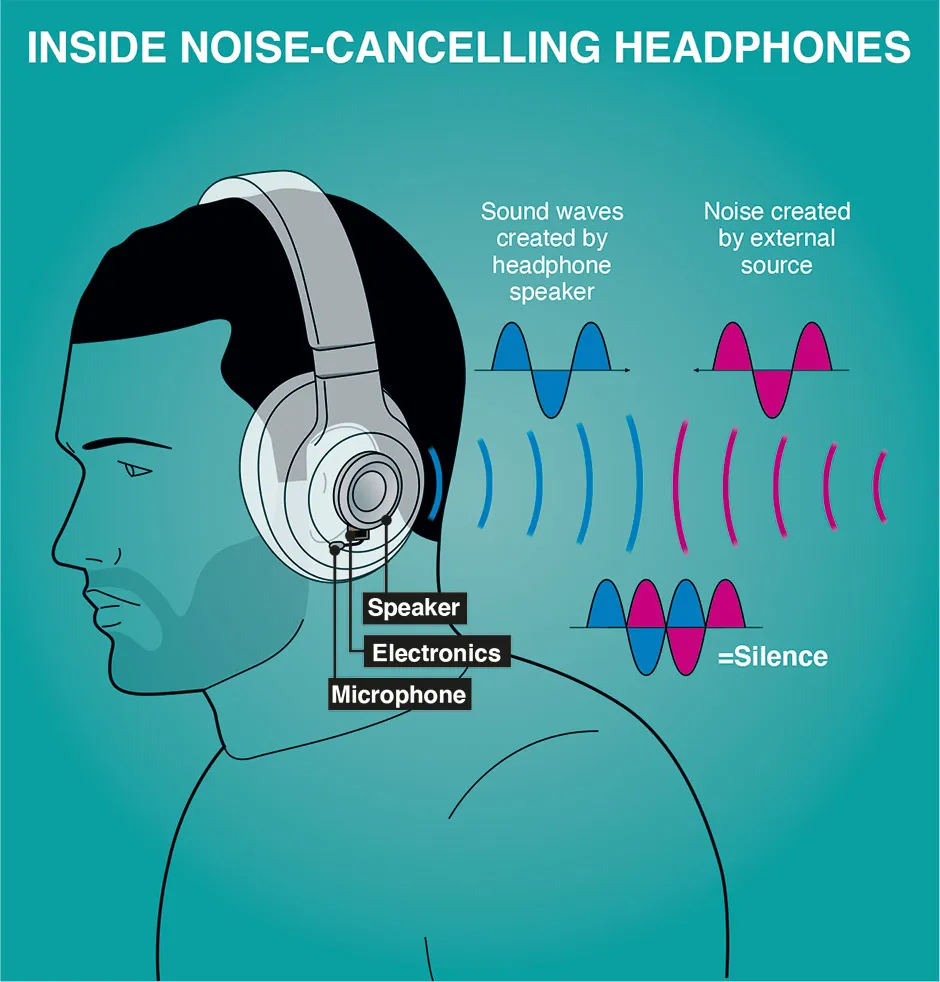Background noise is annoying. Whether it’s the hiss of an air-conditioning system, the hum of traffic or the drone of a passenger jet’s engine, if it’s too loud to ignore then it makes it difficult to hear, let alone enjoy, what you want to listen to – even if it’s just the ‘sound’ of your thoughts.
But what if, instead of cranking up the volume on your music, movie or inner musings to unhealthy levels, you could turn down the volume on the background noise? Sounds like a tempting proposition, right? Well it’s essentially what noise-cancelling headphones promise to do…
What is noise-cancellation?
Ultimately, it’s anything that insulates you from sounds you don’t want to hear. But the term typically refers to features built into headphones to keep external, intrusive sounds from interfering with whatever it is you’re trying to listen to, even if it’s nothing.
Generally speaking, noise cancellation comes in two forms: it’s either passive or active. They both set out to achieve the same thing, but they go about it in different ways.

So what’s the difference between passive and active noise cancellation?
Essentially, passive noise cancellation absorbs intrusive sounds while active noise cancellation suppresses them.
Passive noise cancellation uses materials and structures in the body of the headphones to either muffle the intrusive noise or prevent it from reaching your ears.
It’s the ear cups and squishy rubber cushions that seal off your ears, along with the springy headband that keeps them pinned to the sides of your head. All over-the-ear headphones feature passive noise cancellation, to some extent.
Active noise cancellation, on the other hand, is a little more advanced and relies on microphones and speakers to detect the intrusive sounds and neutralise them.
Black Friday noise-cancellation headphones
If you're in the market for some noise-cancelling headphones, now is a great time to buy a pair. We are currently in the week of Black Friday, complete with big discounts across a range of brands. Below we've listed the most significant savings on headphones from the sale:
- Sony WH-1000XM5: at Amazon (
£380£295.91) - Sennheiser HD 599: at Amazon (
£179.99£69.99 - Sony WF-1000XM4: at Amazon (
£250£159) - Beats Studio 3: at Amazon (
£349.95£179) - Anker Soundcore: at Amazon (
£79.99£55.98)
How does active-noise cancellation work?
It cancels out intrusive sounds using destructive interference or ‘anti-sound’. In other words, it uses sound-waves that are the exact opposite of those of the intrusive sound to suppress the intrusive sound before it reaches your ears.
Headphones with active-noise cancellation carry small microphones to pick up intrusive sounds. Those sounds are fed into the active-noise cancellation processor, which analyses them and produces the opposite, anti-sound version of them.
The anti-sound is then played through the speakers in the headphones to neutralise the intrusive sound so that you don’t hear it.
Does active-noise cancellation actually work?
It’s not perfect, but it’s pretty good. It might not be able to seal you in a bubble of silence (yet) but it’s more than capable of drowning out the background drone of travelling on public transport or the hum of jet engines during a plane flight.
The reason it works so well with these types of noises is that they’re regular and sit in the lower range of sound frequencies.
To put it another way, they’re fairly predictable, so the active-noise cancellation processor has an easier time of dealing with them. Louder, irregular, higher frequency sounds (think crying children and barking dogs) are a little too much for active-noise cancellation to deal with, hence the presence of passive noise-cancellation features on most headphones.

Are noise-cancelling headphones bad for my ears?
No. In fact, when it comes to your hearing, they may actually be better for you since you’re less likely to crank the volume up to drown out any unwanted noise.
That said, any sort of internet search for active-noise-cancelling headphones is likely to turn up stories from people who’ve experienced uncomfortable pressure on their eardrums, and in some cases jaw pain and headaches, while using them.
These symptoms are frequently attributed to the pressure changes in your ear canal, but the culprit is more likely to be your brain. The lack of low-frequency sounds (due to them being drowned out by the noise-cancelling headphones) tricks your brain into thinking there’s been a drop in air pressure.
Under normal circumstances, when there really has been a drop in air pressure, it causes a sensation of suction on your eardrums. But in this case, it’s just your brain falling into that familiar pattern.
Where you’re more likely to get into trouble with noise-cancelling headphones is if you’re using them around traffic, as the noise of approaching vehicles may be suppressed.
Equally, it should be made clear that noise-cancelling headphones do not provide protection from loud noises, which could still damage your hearing. You’ll want ear defenders if you’re going anywhere near loud noises.
Is it only headphones that have noise-cancelling technology?
You can find it on some microphones too – often on the mics you get on the headsets used for gaming or making hands-free phone calls, but also on those found on some Dictaphones and digital voice recorders. It might be something as simple as a spongey or fluffy cover (passive noise cancellation) or, in some cases, multiple mics to isolate and cancel out background sounds (active noise cancellation).
Read more: